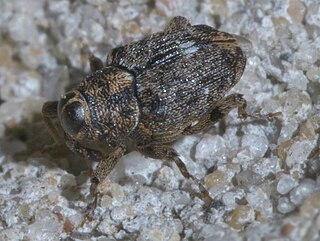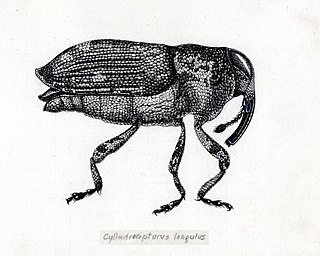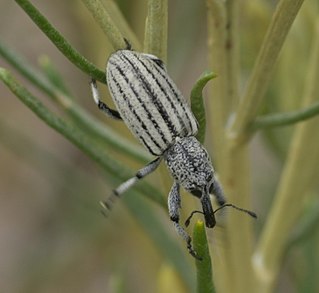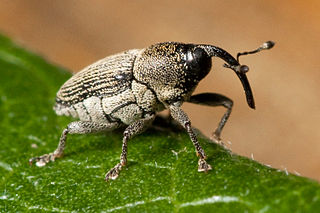
Lechriopini is a tribe of true weevils in the beetle family Curculionidae. There are more than 20 genera and 510 described species in Lechriopini.

Cylindrocopturus is a genus of weevil in the tribe Zygopini. It was initially described by Heller in 1895. Although included in the Lechriopini by some early sources, it has been included in the Zygopini in all more recent works. Species in Cylindrocopturus have an unmodified mesoventrite and do not have sclerolepidia. Two Cylindrocopturus species, C. eatoni and C. furnissi, are considered pests.

Zygopini is a tribe of twig and stem weevils in the beetle family Curculionidae. There are more than 20 genera and at least 250 described species in Zygopini. 83 species are currently known from the 11 genera occurring north of South America, 8 genera occur exclusively in South America, and 2 are recorded from Africa.

Otidocephalini is a tribe of antlike weevils in the family of beetles known as Curculionidae. There are at least 3 genera and 20 described species in Otidocephalini.

Apostasimerini is a tribe of flower weevils in the family of beetles known as Curculionidae. There are at least 30 genera and hundreds of described species in Apostasimerini.

Conoderinae is a subfamily of true weevils in the beetle family Curculionidae. There are more than 210 genera in 15 tribes, and about 2,400 described species in Conoderinae.

Mecinini is a tribe of true weevils in the family of beetles known as Curculionidae. There are at least three genera and about eight described species in Mecinini.

Myllocerus is a genus of oriental broad-nosed weevils in the beetle family Curculionidae. There are at least 330 described species in Myllocerus.

Cnemogonini is a tribe of minute seed weevils in the family of beetles known as Curculionidae. There are about 11 genera and at least 20 described species in Cnemogonini.

Tychiini is a tribe of leguminous seed weevils in the family of beetles known as Curculionidae. There are about 5 genera and at least 30 described species in Tychiini.

Platystomini is a tribe of fungus weevils in the beetle family Anthribidae. There are 4 genera and over 100 described species in North America, and many others worldwide.

Derelomini is a tribe of true weevils in the family of beetles known as Curculionidae. There are about five genera and eight described species in Derelomini.

Mesoptiliinae is a subfamily of true weevils in the family Curculionidae. There are at about 23 genera and 40 described species in Mesoptiliinae.
Gasterocercini is a tribe of hidden snout weevils in the family of beetles known as Curculionidae. There are at least four genera and about eight described species in Gasterocercini.
Orthognathini is a tribe of true weevils in the family of beetles known as Curculionidae.

Ellescini is a tribe of true weevils in the family of beetles known as Curculionidae. There are at least 3 genera and about 18 described species in Ellescini.

Scleropterini is a tribe of minute seed weevils in the family of beetles known as Curculionidae. There are at least eight genera in Scleropterini.

Smicronychini is a tribe of true weevils in the family of beetles known as Curculionidae. There are at least 7 genera in Smicronychini.

Lignyodina is a subtribe of leguminous seed weevils in the family of beetles known as Curculionidae. There are at least 2 genera and about 15 described species in Lignyodina.
Othippiini is a tribe of true weevils in the beetle family Curculionidae. Of the eight genera in Othippiini, only Egiona and Othippia are not monotypic. Acoptus suturalis is the only species of the tribe found in the New World.














